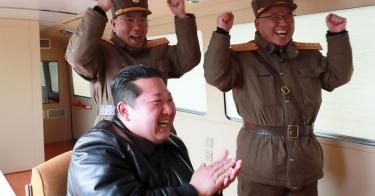North Korea has issued a series of truculent missives warning of dire, though unspecified, military actions in an attempt to intimidate the U.S. and its allies into canceling planned military exercises.
Pyongyang responded strongly last year when Washington and Seoul restored large-scale military exercises and resumed deployment of nuclear-capable strategic assets after a four-year hiatus.
North Korean dictator Kim Jong Un again may go on a missile-launching binge and initiate extensive drills of conventional forces near the demilitarized zone.
Kim’s regime could also conduct its seventh nuclear test or launch an intercontinental ballistic missile over Japan that would escalate tensions and potentially demonstrate capability to deliver multiple nuclear warheads.
Allies Restore Deterrence Capabilities
In 2022, the U.S. and South Korea resumed combined military exercises to repair the degradation of allied deterrence and defense capabilities wrought by the unilateral U.S. decision in 2018 to cancel, reduce, and constrain military exercises on the Korean Peninsula.
Late last year, Washington and Seoul conducted wide-ranging air, naval, and ground maneuvers on and near the Korean Peninsula.
To build on the positive momentum, Washington and Seoul announced they would conduct at least 20 combined training programs in 2023 commensurate in size to the large-scale Foal Eagle field training exercises of the past. The Freedom/Warrior Shield exercises that started Monday will be the largest and longest drills in at least five years.
Defense Secretary Lloyd Austin said the United States also would increase its deployment of strategic assets—including bombers, submarines, and aircraft carriers—to the Korean Peninsula. A Nimitz-class aircraft carrier will arrive in South Korea by the end of the month.
So far this year, the U.S. and South Korea have completed five combined air drills involving U.S. strategic bombers escorted by U.S. and South Korean fighters. The two militaries also conducted the first of several planned Buddy Wing air precision ground attack exercises and the Teak Knife special operations drill practicing a decapitation operation against North Korean leadership.
North Korea Hurls Invective and Threats
As it did last year, Pyongyang criticized the resumption of allied military exercises and rotational deployment of U.S. strategic assets, which it depicts as precursors to a U.S. and South Korean attack.
Kim’s regime warned that the allied exercises were tantamount to a “declaration of war,” had created an “extremely dangerous situation,” and would plunge the Korean Peninsula into “the grave vortex of escalating tension.”
The regime repeatedly threatened retaliatory responses if the U.S. and its allies don’t cancel future exercises. Kim Yo Jong, the North Korean leader’s powerful sister, denounced the allied military exercises with invective-laden declarations warning that North Korea would “take corresponding and very powerful and overwhelming counteraction against every move hostile to us.”
Although Pyongyang has not specified what actions it would take, she hinted that the regime might conduct a full-range ICBM flight over Japan to demonstrate unambiguously the survivability of its reentry vehicles carrying nuclear weapons. To date, Pyongyang has launched all of its ICBMs on high-angle, lofted trajectories so as to not fly over neighboring countries.
Kim Yo Jong declared that Pyongyang’s decision to use “the Pacific as our firing range” depended on the allies’ cancellation of military exercises. In response to unconfirmed reports that Adm. John Aquilino, commander of U.S. Indo-Pacific Command, had said the U.S. would intercept any North Korean ICBM fired into the Pacific, Kim warned that doing so would be a “declaration of war” leading the regime to respond with “appropriate, quick, and overwhelming action at any time.”
Another potential North Korean action would be to conduct its seventh nuclear test, which Washington and Seoul have said was “imminent” since March 2022. The test is expected to be much smaller than the 250-kiloton explosion in 2017, instead testing a new generation of low-yield tactical nuclear weapons for battlefield use.
Extensive North Korean Military Moves Expected
Although a full-range ICBM flight and nuclear test are possibilities, North Korea almost certainly will respond to allied exercises, as it did last year, with numerous missile launches and its own large-scale military movements.
In 2022, Pyongyang cumulatively launched a record-high 69 ballistic and six long-range cruise missiles. Many of these launches occurred during the allied exercises in September and October and included salvo launches of multiple missiles simulating nuclear attacks on South Korean ports, airfields, and hardened military command targets.
During allied exercises last autumn, North Korean air, ground, and naval forces also conducted significant military operations close to South Korea, many on a scale never seen before. Pyongyang conducted rare air-attack drills close to the DMZ and a large bombing and air-to-air attack drill with more than 150 fighter planes.
North Korean ground forces fired over a thousand artillery rounds into waters off its east and west coasts. The shells landed in maritime buffer areas near the border, in violation of an inter-Korean military agreement. North and South Korean naval forces exchanged warning shots off the west coast after a North Korean freighter strayed south of the maritime boundary line.
Rough Waters Ahead
The U.S. decision to reduce the “size, scope, volume, and timing” of four years of allied military exercises in South Korea didn’t lead to any change in North Korean military activity nor reciprocal diplomatic gestures.
As Pyongyang continues to augment and diversify its military threat to South Korea, Japan, and the United States, it is critically important to restore allied deterrence and defense capabilities.
North Korea often has used provocations and threats to drive a wedge between the United States and its allies. Instead, its recent behavior has led the U.S., South Korea, and Japan to strengthen their militaries and enhance defense cooperation.
Washington and its allies must continue to respond resolutely to Pyongyang’s growing threat and willingness to raise tensions.
This piece originally appeared in The Daily Signal



